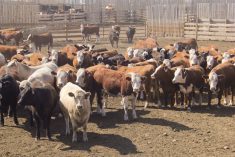Chicago | Reuters — Chicago Mercantile Exchange (CME) lean hogs fell to their lowest level in five years Wednesday as abundant supplies of heavyweight hogs pressured cash prices and hurt wholesale pork demand, traders said.
“We’re simply supply-bearish,” said U.S. Commodities analyst Don Roose.
Market-ready (cash) hogs in the Midwest sold steady to $1 lower per hundredweight (cwt) early on Wednesday, regional hog dealers said (all figures US$).
The morning’s wholesale pork price was at $76.67/cwt, a gain of 42 cents from Tuesday, the U.S. Department of Agriculture said.
Read Also

Trump mulls ending some trade ties with China, including in relation to cooking oil
U.S. President Donald Trump said on Tuesday Washington was considering terminating some trade ties with China, including in relation to cooking oil.
Moderate winter temperatures kept hog weights from declining as they normally would at this time of year, analysts said.
They also said that more hogs are available than expected due to the use of vaccines and enhanced biosecurity measures on farms that reduced the impact of the deadly porcine epidemic diarrhea virus (PEDv).
A combination of U.S. West Coast port gridlock and East Coast residents digging out from a recent severe blizzard stifled overall meat sales, traders said.
February closed 2.1 cents/lb. lower at 65.1 cents, and April slumped 2.75 cents to 68.125 cents. June and July futures fell by the three-cents-per-pound price limit, settling at 79.625 cents and 79.95 cents, respectively.
Live cattle drop
CME live cattle futures felt pressure from lean hogs’ selloff and uneasiness about increased cattle supplies ahead, traders said.
Last Friday’s USDA cattle inventory report showed cheaper feed and record-high cattle prices in 2014 encouraged ranchers to expand herds more aggressively than previously expected.
February live cattle futures remained underpriced compared preliminary cash prices, which minimized that contract’s losses.
On Wednesday, some cash cattle moved in Kansas at $160/cwt, steady to up $1.50 from last week’s mostly $159-$160.50 sales in the U.S. Plains, said feedlot sources.
They said remaining cash bids stand at $160/cwt against feedlots asking up to $162 for their cattle.
Some packers need cattle after not buying enough of them last week, while others might bridle cash spending due to their poor margins and sluggish wholesale beef demand.
February closed 0.75 cent/lb. weaker at 153 cents, and April down 1.925 cents, at 148.65 cents.
CME feeder cattle traded in sympathy with lower live cattle futures.
March closed 2.775 cents/lb. lower at 196.725 cents/lb., and April down 3.05 cents, to 196.85 cents.
— Theopolis Waters reports on livestock futures markets for Reuters from Chicago.
















